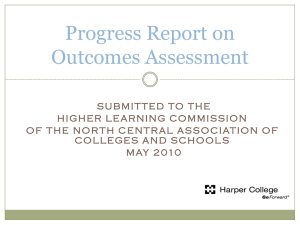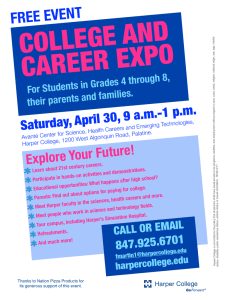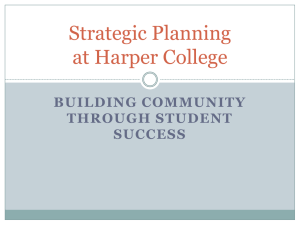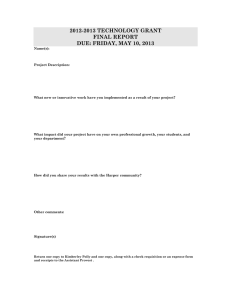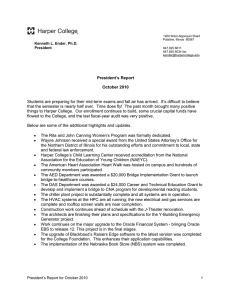Document 12589965
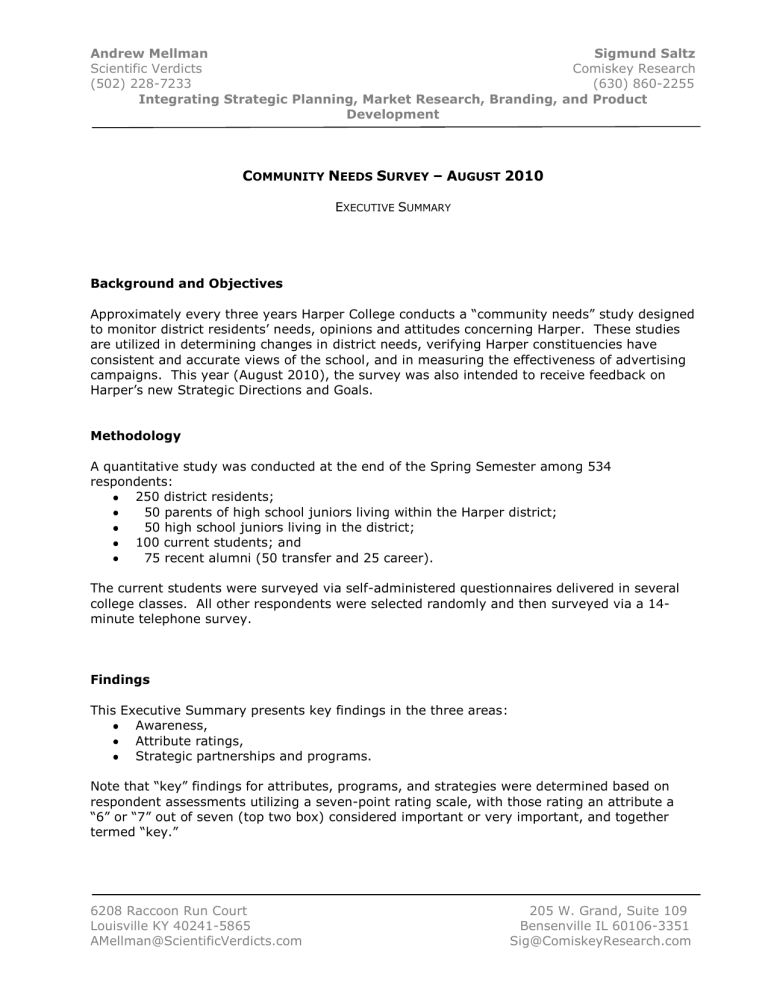
Andrew Mellman Sigmund Saltz
Scientific Verdicts Comiskey Research
(502) 228-7233 (630) 860-2255
Integrating Strategic Planning, Market Research, Branding, and Product
Development
C OMMUNITY N EEDS S URVEY – A UGUST 2010
E XECUTIVE S UMMARY
Background and Objectives
Approximately every three years Harper College conducts a “community needs” study designed to monitor district residents’ needs, opinions and attitudes concerning Harper. These studies are utilized in determining changes in district needs, verifying Harper constituencies have consistent and accurate views of the school, and in measuring the effectiveness of advertising campaigns. This year (August 2010), the survey was also intended to receive feedback on
Harper’s new Strategic Directions and Goals.
Methodology
A quantitative study was conducted at the end of the Spring Semester among 534 respondents:
250 district residents;
50 parents of high school juniors living within the Harper district;
50 high school juniors living in the district;
100 current students; and
75 recent alumni (50 transfer and 25 career).
The current students were surveyed via self-administered questionnaires delivered in several college classes. All other respondents were selected randomly and then surveyed via a 14minute telephone survey.
Findings
This Executive Summary presents key findings in the three areas:
Awareness,
Attribute ratings,
Strategic partnerships and programs.
Note that “key” findings for attributes, programs, and strategies were determined based on respondent assessments utilizing a seven-point rating scale, with those rating an attribute a
“6” or “7” out of seven (top two box) considered important or very important, and together termed “key.”
6208 Raccoon Run Court 205 W. Grand, Suite 109
Louisville KY 40241-5865 Bensenville IL 60106-3351
AMellman@ScientificVerdicts.com Sig@ComiskeyResearch.com
I.
Findings – Awareness
“When you think of colleges and universities in your area, which come to mind? Any others?”
Overall, Harper was the most frequently recalled area college or university, as 41% mentioned
Harper first when asked about local area colleges and an additional 20% mentioned Harper later in their list of schools with which they were aware (for a total awareness of 61%).
This is slightly below what was seen in the 2007 Harper Community Survey (74%), but similar to what was seen in 2003. The 2010 responses to the most frequently recalled college is significantly above level seen in the 2000 Harper Community Survey (44%).
The 2007 Harper results are viewed as unique since the College was engaged in several high profile efforts that most likely contributed to the higher recognition:
A capital campaign by the Harper Foundation
Celebration of the College’s 40 th anniversary
Increased public relations efforts in preparation for potential bond referendum
Soliciting public feedback regarding the College’s performance as part of its
U of I – Chicago was the second most frequently mentioned school in both 2010 and 2007. reaccreditation self-study for the Higher Learning Commission of the North
Central Association of Schools and Colleges
“Which Community College serves your area?
90% knew that Harper was their local community college, similar to what had been seen in prior surveys. In 2010, only 44% of those living in the district for fewer than five years knew
Harper was their community college.
“In your opinion, what is Harper College best known for?”
The top responses for the last three studies were:
2010
Academics
PriceValue
Location 10
17
78
2007
Academics
Price/Value
Location
14
13
54
% Mentioning
2003
Price/Value
Location
0
10
10
20 40 60 80 100
Note that “Academics” represents the sum of three responses:
Academic reputation
Mention of a specific major or the comment “Harper offers/offered my major” and
Has a good transfer program
Specific majors were not individually tracked.
In 2003 (and 2000) the most frequent response was “nothing.”
II.
Findings – Attributes
“In general, a Community College can play a large number of roles for the people in its district.
Using a 7 point scale, where 7 means extremely important, and 1 not at all important, or you can choose any number in between, please tell me how important it is for Harper College, your
Community College, to offer the following:”
Attributes were measured based on responses to a seven-point rating scale, with those rating the attribute a “6” or “7” out of seven (top two box) measured and compared.
The top five attributes from the past two studies were:
2010
Safe Environment
Transfer Programs
Competitive Tuition
Faculty that Interacts with Students
Faculty with Real Experience
86
85
89
93
93
2007
Quality of Teaching
Academic Reputation
Value
Courses on My Schedule
Safety 80
86
86
89
95
Top Two Box
70 75 80 85 90 95 100
Prior years’ studies tended to feature availability of technology and financial aid over the above variables.
III.
Findings – Strategic Partnerships and Programs
“The college currently has some partnerships and is considering others with a wide range of groups and organizations within the Harper District. Using the same 7 point scale we used earlier, where 7 is very important, 1 is not at all important, or you can use any number in between, how important is it for Harper College to offer a partnership with . . . “
“Harper College currently has a number of programs and is developing others designed to help all students succeed. Again, using the same 7 point scale where 7 is extremely important, 1 is not important, or you can use any number in between, how important is it for Harper to . . . “
While a wide variety of partnerships and programs were examined for importance,
Those deemed most important by respondents tend to relate to more traditional community college goals and values, such as o Assuring transfers; o Fostering long-term lifelong relationships from K-12 through four-year schools and beyond; and o Providing tutoring for all in need.
Those deemed least important tended to deal more with “special interest” groups, such as o Faculty and staff (providing incentives to improve student learning); o At-risk students (provide more remedial courses); and o Businesses (train employees of large businesses).
There are no comparisons regarding strategic partnerships and programs from previous Harper
Community Surveys as this is the first time that Harper surveyed its constituencies on these matters.
